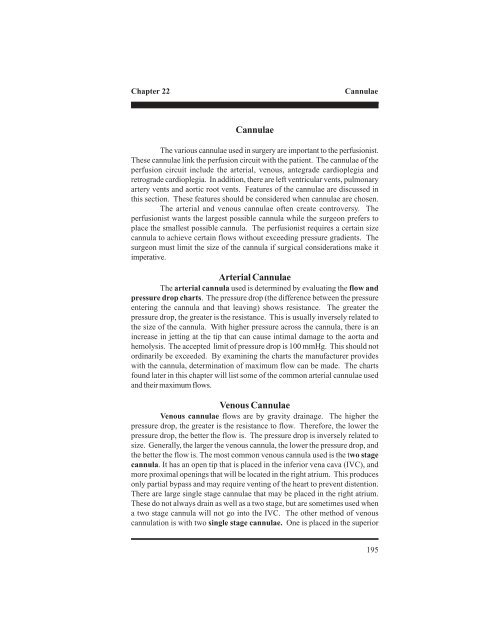Cannulae - Perfusion.com
Cannulae - Perfusion.com
Cannulae - Perfusion.com
Create successful ePaper yourself
Turn your PDF publications into a flip-book with our unique Google optimized e-Paper software.
Chapter 22 <strong>Cannulae</strong><br />
<strong>Cannulae</strong><br />
The various cannulae used in surgery are important to the perfusionist.<br />
These cannulae link the perfusion circuit with the patient. The cannulae of the<br />
perfusion circuit include the arterial, venous, antegrade cardioplegia and<br />
retrograde cardioplegia. In addition, there are left ventricular vents, pulmonary<br />
artery vents and aortic root vents. Features of the cannulae are discussed in<br />
this section. These features should be considered when cannulae are chosen.<br />
The arterial and venous cannulae often create controversy. The<br />
perfusionist wants the largest possible cannula while the surgeon prefers to<br />
place the smallest possible cannula. The perfusionist requires a certain size<br />
cannula to achieve certain flows without exceeding pressure gradients. The<br />
surgeon must limit the size of the cannula if surgical considerations make it<br />
imperative.<br />
Arterial <strong>Cannulae</strong><br />
The arterial cannula used is determined by evaluating the flow and<br />
pressure drop charts. The pressure drop (the difference between the pressure<br />
entering the cannula and that leaving) shows resistance. The greater the<br />
pressure drop, the greater is the resistance. This is usually inversely related to<br />
the size of the cannula. With higher pressure across the cannula, there is an<br />
increase in jetting at the tip that can cause intimal damage to the aorta and<br />
hemolysis. The accepted limit of pressure drop is 100 mmHg. This should not<br />
ordinarily be exceeded. By examining the charts the manufacturer provides<br />
with the cannula, determination of maximum flow can be made. The charts<br />
found later in this chapter will list some of the <strong>com</strong>mon arterial cannulae used<br />
and their maximum flows.<br />
Venous <strong>Cannulae</strong><br />
Venous cannulae flows are by gravity drainage. The higher the<br />
pressure drop, the greater is the resistance to flow. Therefore, the lower the<br />
pressure drop, the better the flow is. The pressure drop is inversely related to<br />
size. Generally, the larger the venous cannula, the lower the pressure drop, and<br />
the better the flow is. The most <strong>com</strong>mon venous cannula used is the two stage<br />
cannula. It has an open tip that is placed in the inferior vena cava (IVC), and<br />
more proximal openings that will be located in the right atrium. This produces<br />
only partial bypass and may require venting of the heart to prevent distention.<br />
There are large single stage cannulae that may be placed in the right atrium.<br />
These do not always drain as well as a two stage, but are sometimes used when<br />
a two stage cannula will not go into the IVC. The other method of venous<br />
cannulation is with two single stage cannulae. One is placed in the superior<br />
195
Chapter 22 The Manual of Clinical <strong>Perfusion</strong><br />
vena cava (SVC) and the other in the IVC. These are connected to a <strong>com</strong>mon<br />
venous line with a Y-connector. This type of cannulation also causes the<br />
effect of partial bypass as the two stage cannula does. That is some blood<br />
manages to go around the cannulae, through the heart and to the lungs. When<br />
the cannulae in the SVC and IVC have either a clamp or umbilical tape pulled<br />
around them, all blood <strong>com</strong>ing to the heart is diverted to the cannulae. This is<br />
termed total bypass. This manner of venous cannulation is most often used in<br />
valvular or congenital surgery. A venous cannulae chart will be listed later in<br />
this chapter. This chart suggests the cannulae used with certain weight<br />
categories.<br />
Cardioplegia <strong>Cannulae</strong><br />
The other cannulae used during bypass are specific to certain<br />
procedures. Retrograde cardioplegia is a popular technique of giving<br />
cardioplegia. The cannula is placed into the coronary sinus through the right<br />
atrium. The cannula has a balloon near its tip that when inflated prevents the<br />
flow of the cardioplegia back into the right atrium. The flow is, instead, forced<br />
backwards through the coronary veins, capillaries and arteries. The cannulae<br />
are of two basic types: either automatic or manual balloon inflation. Selection<br />
is surgeon preference.<br />
Antegrade cardioplegia is given through a cannula in the aortic root<br />
or directly into the coronary os. (When given directly into the os a coronary<br />
perfusion cannula is used.) These cannulae <strong>com</strong>e in various sizes and in different<br />
configurations. Basically, they have short needle tips that are placed into the<br />
aorta. Cardioplegia is then given into the root. The aortic valve and the aortic<br />
cross clamp prevent flow in either direction and thus force the cardioplegia<br />
into the coronary arteries. Some have an extra arm <strong>com</strong>ing off the side to allow<br />
a vent tubing to be connected and thus provide both functions in turn. The<br />
sizes of these cannulae affect the pressure drop and thus the maximum flow.<br />
Selection is surgeon preference.<br />
Coronary perfusion cannulae <strong>com</strong>e in different sizes and shapes. A<br />
<strong>com</strong>mon design is the small hand held cannula with a soft tip that is placed<br />
over the coronary os. Others have tips that engage the coronary os. These<br />
cannulae are used when the aortic root is opened for a valve replacement.<br />
Since the development of the retrograde cannula these cannulae are not often<br />
used. Retrograde delivery is easier and may be done while the surgeon continues<br />
to work.<br />
Vents<br />
The LV vents, PA vents and aortic root vents are the last of the cannulae<br />
types to be discussed. These vents are available in many sizes and shapes.<br />
The type of vent depends on the cannulation site. There are short metal tipped<br />
needles that fit in the aortic root. There are long thin cannulae placed through<br />
196
Chapter 22 <strong>Cannulae</strong><br />
the right superior pulmonary vein, through the mitral valve and into the left<br />
ventricle. There are short right angled cannulae that may be placed into the<br />
apex of the left ventricle. There are cannulae placed in the main pulmonary<br />
artery distal to the pulmonary valve. The selection of these cannulae depends<br />
on the vent placement the surgeon prefers and the type cannula he prefers.<br />
NOTE: Always use a one-way valve in pump tubing connected to a<br />
vent to prevent accidental introduction of air into either the aorta or the left<br />
ventricle.<br />
The following is a chart of arterial cannulae, their pressure drops and<br />
maximum flows. These values <strong>com</strong>e from flow charts provided with the products.<br />
The venous cannulae chart is one that lists the standard re<strong>com</strong>mendations at<br />
certain weights. The charts are general re<strong>com</strong>mendations and more specific<br />
information can be obtained from the manufacturers.<br />
NOTE: On the arterial charts many cannulae reached the maximum<br />
flow on the chart before reaching the 100mmHg pressure drop. In these<br />
cases the maximum flow listed is actually less than its maximum flow that<br />
could be achieved at the 100mmHg pressure drop.<br />
ARTERIAL CANNULAE<br />
model size(OD) flow ( L/min ) pressure drop<br />
mmHg<br />
Bard<br />
Opti-Clear Aortic Arch 18 FR 4.75 100<br />
Opti-Clear Aortic Arch 20 FR 6.25 100<br />
Opti-Clear Aortic Arch 22 FR 7 70<br />
Opti-Clear Aortic Arch 24 FR 7 50<br />
Bio Medicus - Femoral<br />
96530-015 15 FR 3 100<br />
96530-017 17 FR 4 100<br />
96530-019 19 FR 5.5 100<br />
96530-021 21 FR 6.5 100<br />
DLP - curved tip arterial<br />
model 83020 20 FR 6.5 100<br />
model 83022 22 FR 8 81<br />
model 83024 24 FR 9 68<br />
DLP - descending arch cannula<br />
71321 21 FR 5 100<br />
71324 24 FR 6 100<br />
197
Chapter 22 The Manual of Clinical <strong>Perfusion</strong><br />
ARTERIAL CANNULAE<br />
model size(OD) flow ( L/min ) pressure drop<br />
mmHg<br />
Gish-Curved tip, wire reinforced, with vent plug<br />
RA-1116 18FR 5.2 100<br />
RA-1117 21FR 6 56<br />
RA-1118 24FR 6 31<br />
Gish-Straight tip with vented connector<br />
NA-2116 18FR 5.2 100<br />
NA-2117 21FR 6 56<br />
NA-2118 24FR 6 31<br />
Research Medical<br />
ARL-2011-90-TA 20 FR 5.9 100<br />
ARL-2211-90-TA 22 FR 6 60<br />
ARL-2411-90-TA 24 FR 6 35<br />
Research Medical - Femoral arterial cannulae<br />
TF-A-020-25 20FR 3.3 100<br />
TF-A-022-25 22FR 5.25 100<br />
TF-A-024-25 24FR 6.2 100<br />
TF-A-024-25-H 24FR 7 87<br />
Sarns<br />
High Flow Aortic Arch 3.8 mm 1.5 100<br />
High Flow Aortic Arch 5.2 mm 3.5 100<br />
High Flow Aortic Arch 6.5 mm 5.25 100<br />
High Flow Aortic Arch 8.0 mm 8 60<br />
Sorin<br />
A211-30 3.0 mm 1.2 100<br />
A211-38 3.8 mm 1.8 100<br />
A211-45 4.5 mm 2.9 100<br />
A211-52 5.2 mm 4.1 100<br />
A211-65 6.5 mm 6.3 90<br />
A211-80 8.0 mm 6.5 40<br />
A211-95 9.5 mm 6.5 20<br />
198
Chapter 22 <strong>Cannulae</strong><br />
model size(OD) flow ( L/min ) pressure drop<br />
mmHg<br />
William Harvey - Bard Arterial<br />
Type 1858 18 FR 4 100<br />
Type 1858 20 FR 5.5 100<br />
Type 1858 22 FR 6 85<br />
Type 1858 24 FR 6 70<br />
William Harvey - Bard Arterial<br />
Type 1860 18 FR 4 100<br />
Type 1860 20 FR 5 100<br />
Type 1860 22 FR 6 85<br />
Type 1860 24 FR 6 50<br />
VENOUS CANNULAE<br />
weight in kgs SVC/IVC <strong>Cannulae</strong> RA Cannula<br />
in French size in French size<br />
0-3 12 / 12 18<br />
3-6 12 / 14 18<br />
6-8 14 / 14 20<br />
8-10 14 / 16 22<br />
10-12 16 / 16 24<br />
12-15 16 / 20 24<br />
15-20 20 / 20 26<br />
20-25 20 / 24 28<br />
25-30 24 / 24 28<br />
30-35 26 / 26 30<br />
35-40 28 / 28 32<br />
40-50 30 / 30 36<br />
50-60 30 / 32 36<br />
60-70 32 / 32 51<br />
70-80 34 / 34 51<br />
80-90 34 / 36 51<br />
90-100 36 / 36 51<br />
100-110 36 / 38 51<br />
110-120 38 / 38 51<br />
120-130 38 / 40 51<br />
130-140 40 / 40 51<br />
199
Chapter 22 The Manual of Clinical <strong>Perfusion</strong><br />
NOTES<br />
———————————————————————————————<br />
———————————————————————————————<br />
———————————————————————————————<br />
———————————————————————————————<br />
———————————————————————————————<br />
———————————————————————————————<br />
———————————————————————————————<br />
———————————————————————————————<br />
———————————————————————————————<br />
———————————————————————————————<br />
———————————————————————————————<br />
———————————————————————————————<br />
———————————————————————————————<br />
———————————————————————————————<br />
———————————————————————————————<br />
———————————————————————————————<br />
———————————————————————————————<br />
———————————————————————————————<br />
———————————————————————————————<br />
———————————————————————————————<br />
———————————————————————————————<br />
———————————————————————————————<br />
———————————————————————————————<br />
———————————————————————————————<br />
———————————————————————————————<br />
———————————————————————————————<br />
———————————————————————————————<br />
———————————————————————————————<br />
———————————————————————————————<br />
———————————————————————————————<br />
———————————————————————————————<br />
———————————————————————————————<br />
———————————————————————————————<br />
———————————————————————————————<br />
———————————————————————————————<br />
———————————————————————————————<br />
———————————————————————————————<br />
———————————————————————————————<br />
———————————————————————————————<br />
200

















